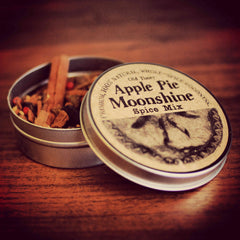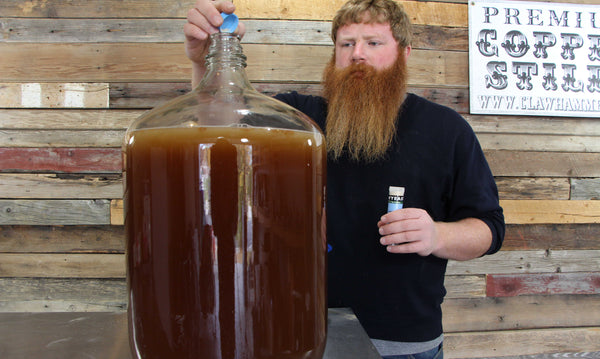
Apple "Moonshine" Mash - Easy Version
The easiest apple moonshine mash recipe would be to mix off the shelf, high proof spirits with an apple pie spice mix. We've done the hard part and have created the perfect blend of apple pie moonshine spices for you!
Apple not your flavor? Check out the rest of our moonshine recipes.
Apple Brandy Advanced Recipe
This advanced recipe we developed involves the distillation of alcohol, for which federal, state, and local permits are needed. We had a fuel alcohol permit when we tested this procedure and we were in compliance with state and federal regulations. We produced, stored, and used this alcohol in accordance with TTB requirements. We also kept and reported production logs in accordance with TTB fuel alcohol permit requirements. Do not try this without the proper permits.
To clarify, distilled fruit wine is typically called "Brandy." However, there are commercial examples of un-aged apple brandy that have been labeled "moonshine." This is the distillers' preference. That said, the first step in the process of making apple "moonshine," or brandy, is to actually make apple wine. After the apple wine has finished fermenting, it can be turned into high proof spirits through the process of distillation.
Ingredients
- 25 pounds of ripe apples ( 1/2 bushel. We used a mixed variety of apples which worked out really well)
- 5-10 pounds cane sugar (We found added 1-2 pounds per gallon of mash worked really well)
- Enough water to reach 5 gallons of total liquid after juicing the apples
- 2.5 teaspoon yeast nutrient (We just followed the directions on the label. The brand we used required 1/2 tsp per gallon)
- 1 packet dry wine yeast
Mashing Equipment
- Pleasant Hill MacIntosh Fruit Press 3-5 Gallon
- Pleasant Hill Maximizer Fruit Grinder
- 6.5 gallon fermenter with airlock
- Large pot for mashing
- Mash paddle or spoon
- Brewing/Wine hydrometer or refractometer
- Brewing thermometer
Target Apple Wine Stats
- Starting Gravity: 1.065
- Ending Gravity: 1.000
- Wash Alcohol By Volume: (ABV) 8.5%
- Spirit ABV: 40% (80 Proof)
- Time to Ferment: 7-14 Days (can vary depending on yeast and temp)
- Fermentation temperature: 70F
 If you're into short cuts, you might want to check out our Apple Pie Moonshine Spice Kit before reading the rest of this recipe. It produces an awesome apple "shine" using a secret mix of spices and off the shelf alcohol!
If you're into short cuts, you might want to check out our Apple Pie Moonshine Spice Kit before reading the rest of this recipe. It produces an awesome apple "shine" using a secret mix of spices and off the shelf alcohol!
Mashing And Fermentation Process
1. We picked a half bushes of apples. When making apple wine the more acidic and sour varieties of apples are best (Winesap, McIntosh, and Jonathans all work great)7. Collected the apple juice in a sanitized bucket
8. Once all of the apples were juiced, we added the juice into the mash pot.
13. Our original gravity was 1.013


























Leave a comment